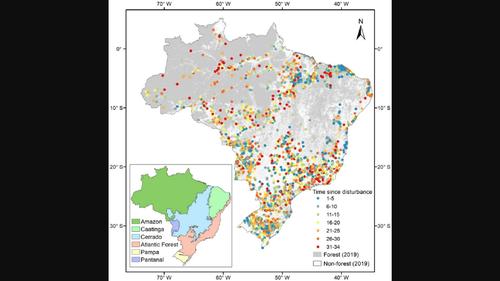利用多源遥感数据表征巴西再生森林的地上生物量和树木覆盖
IF 3.9
2区 环境科学与生态学
Q1 ECOLOGY
引用次数: 1
摘要
重新生长森林的特征对于了解森林动态、评估对碳储量的影响和支持可持续森林管理至关重要。虽然遥感是了解和监测森林动态的关键工具,但利用完全遥感数据来探索巴西所有生物群落中不同变量对森林再生的影响的研究很少。在这里,我们分析了环境和人为因素对森林再生的影响。根据巴西的次生林年龄图,在1984年至2018年期间对3060个受干扰的地点进行了采样、解释和分析。我们对谷歌Earth Engine中采样像素的自扰动时间进行了解释。分析了海拔、坡度、气候水分亏缺(CWD)、土壤全氮、土壤阳离子交换容量(CEC)、周围树木覆盖、到道路的距离、到居民点的距离和火灾频率对全球森林地上生物量(AGB)和树木覆盖预测的重要性。结果表明,卫星时间序列解译的自扰动时间是表征再生林AGB和树木覆盖最重要的预测因子。AGB随干扰时间、周围树木覆盖、土壤全氮、坡度、道路距离、居民点距离的增加而增加,随火灾频率、CWD和CEC的增加而降低。随着干扰时间、土壤全氮、周围树木覆盖、到道路的距离、到聚落的距离、坡度的增加,树木覆盖增加,随着海拔高度和海拔高度的增加而减少。这些结果强调了遥感产品作为改善森林再生特征和减少与森林碳汇估算有关的数据差距和不确定性的关键机会的重要性。我们的研究结果为更好地了解区域森林动态,制定和评估有效的森林相关恢复和气候缓解策略提供了依据。本文章由计算机程序翻译,如有差异,请以英文原文为准。

Characterizing aboveground biomass and tree cover of regrowing forests in Brazil using multi‐source remote sensing data
Characterization of regrowing forests is vital for understanding forest dynamics to assess the impacts on carbon stocks and to support sustainable forest management. Although remote sensing is a key tool for understanding and monitoring forest dynamics, the use of exclusively remotely sensed data to explore the effects of different variables on regrowing forests across all biomes in Brazil has rarely been investigated. Here, we analyzed how environmental and human factors affect regrowing forests. Based on Brazil's secondary forest age map, 3060 locations disturbed between 1984 and 2018 were sampled, interpreted and analyzed in different biomes. We interpreted the time since disturbance for the sampled pixels in Google Earth Engine. Elevation, slope, climatic water deficit (CWD), the total Nitrogen of soil, cation exchange capacity (CEC) of soil, surrounding tree cover, distance to roads, distance to settlements and fire frequency were analyzed in their importance for predicting aboveground biomass (AGB) and tree cover derived from global forest aboveground biomass map and tree cover map, respectively. Results show that time since disturbance interpreted from satellite time series is the most important predictor for characterizing AGB and tree cover of regrowing forests. AGB increased with increasing time since disturbance, surrounding tree cover, soil total N, slope, distance to roads, distance to settlements and decreased with larger fire frequency, CWD and CEC of soil. Tree cover increased with larger time since disturbance, soil total N, surrounding tree cover, distance to roads, distance to settlements, slope and decreased with increasing elevation and CWD. These results emphasize the importance of remotely sensing products as key opportunities to improve the characterization of forest regrowth and to reduce data gaps and uncertainties related to forest carbon sink estimation. Our results provide a better understanding of regional forest dynamics, toward developing and assessing effective forest‐related restoration and climatic mitigation strategies.
求助全文
通过发布文献求助,成功后即可免费获取论文全文。
去求助
来源期刊

Remote Sensing in Ecology and Conservation
Earth and Planetary Sciences-Computers in Earth Sciences
CiteScore
9.80
自引率
5.50%
发文量
69
审稿时长
18 weeks
期刊介绍:
emote Sensing in Ecology and Conservation provides a forum for rapid, peer-reviewed publication of novel, multidisciplinary research at the interface between remote sensing science and ecology and conservation. The journal prioritizes findings that advance the scientific basis of ecology and conservation, promoting the development of remote-sensing based methods relevant to the management of land use and biological systems at all levels, from populations and species to ecosystems and biomes. The journal defines remote sensing in its broadest sense, including data acquisition by hand-held and fixed ground-based sensors, such as camera traps and acoustic recorders, and sensors on airplanes and satellites. The intended journal’s audience includes ecologists, conservation scientists, policy makers, managers of terrestrial and aquatic systems, remote sensing scientists, and students.
Remote Sensing in Ecology and Conservation is a fully open access journal from Wiley and the Zoological Society of London. Remote sensing has enormous potential as to provide information on the state of, and pressures on, biological diversity and ecosystem services, at multiple spatial and temporal scales. This new publication provides a forum for multidisciplinary research in remote sensing science, ecological research and conservation science.
 求助内容:
求助内容: 应助结果提醒方式:
应助结果提醒方式:


